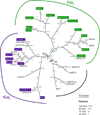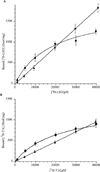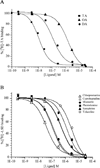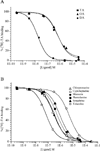Are Caenorhabditis elegans receptors useful targets for drug discovery: pharmacological comparison of tyramine receptors with high identity from C. elegans (TYRA-2) and Brugia malayi (Bm4)
- PMID: 17537528
- PMCID: PMC3430142
- DOI: 10.1016/j.molbiopara.2007.04.004
Are Caenorhabditis elegans receptors useful targets for drug discovery: pharmacological comparison of tyramine receptors with high identity from C. elegans (TYRA-2) and Brugia malayi (Bm4)
Abstract
The biogenic amine, tyramine (TA), modulates a number of key processes in nematodes and a number of TA-specific receptors have been identified. In the present study, we have identified a putative TA receptor (Bm4) in the recently completed Brugia malayi genome and compared its pharmacology to its putative Caenorhabditis elegans orthologue, TYRA-2, under identical expression and assay conditions. TYRA-2 and Bm4 are the most closely related C. elegans and B. malayi BA receptors and differ by only 14aa in the TM regions directly involved in ligand binding. Membranes from HEK-293 cells stably expressing Bm4 exhibited specific, saturable, high affinity, [(3)H]LSD and [(3)H]TA binding with K(d)s of 18.1+/-0.93 and 15.1+/-0.2 nM, respectively. More importantly, both TYRA-2 and Bm4 TA exhibited similar rank orders of potencies for a number of potential tyraminergic ligands. However, some significant differences were noted. For example, chloropromazine exhibited an order of magnitude higher affinity for Bm4 than TYRA-2 (pK(i)s of 7.6+/-0.2 and 6.49+/-0.1, respectively). In contrast, TYRA-2 had significantly higher affinity for phentolamine than Bm4. These results highlight the utility of the nearly completed B. malayi genome and the importance of using receptors from individual parasitic nematodes for drug discovery.
Figures






Similar articles
-
TYRA-2 (F01E11.5): a Caenorhabditis elegans tyramine receptor expressed in the MC and NSM pharyngeal neurons.J Neurochem. 2005 Jul;94(1):181-91. doi: 10.1111/j.1471-4159.2005.03180.x. J Neurochem. 2005. PMID: 15953361
-
Genes encoding putative biogenic amine receptors in the parasitic nematode Brugia malayi.Invert Neurosci. 2007 Dec;7(4):227-44. doi: 10.1007/s10158-007-0058-y. Epub 2007 Nov 20. Invert Neurosci. 2007. PMID: 18027007
-
Characterization of a tyramine receptor from Caenorhabditis elegans.J Neurochem. 2002 Sep;82(6):1352-9. doi: 10.1046/j.1471-4159.2002.01065.x. J Neurochem. 2002. PMID: 12354282
-
Biogenic amine receptors in parasitic nematodes: what can be learned from Caenorhabditis elegans?Mol Biochem Parasitol. 2004 Sep;137(1):1-11. doi: 10.1016/j.molbiopara.2004.05.010. Mol Biochem Parasitol. 2004. PMID: 15279946 Review.
-
RNAi-based discovery and validation of new drug targets in filarial nematodes.Trends Parasitol. 2005 Mar;21(3):97-100. doi: 10.1016/j.pt.2004.12.003. Trends Parasitol. 2005. PMID: 15734653 Review.
Cited by
-
Monoaminergic signaling as a target for anthelmintic drug discovery: receptor conservation among the free-living and parasitic nematodes.Mol Biochem Parasitol. 2012 May;183(1):1-7. doi: 10.1016/j.molbiopara.2012.02.001. Epub 2012 Feb 11. Mol Biochem Parasitol. 2012. PMID: 22343182 Free PMC article. Review.
-
Towards High-Throughput Chemobehavioural Phenomics in Neuropsychiatric Drug Discovery.Mar Drugs. 2019 Jun 6;17(6):340. doi: 10.3390/md17060340. Mar Drugs. 2019. PMID: 31174272 Free PMC article. Review.
-
Assessment of the efficacy of thymol against Toxocara vitulorum in experimentally infected rats.J Parasit Dis. 2022 Jun;46(2):454-465. doi: 10.1007/s12639-022-01465-7. Epub 2022 Jan 30. J Parasit Dis. 2022. PMID: 35692468 Free PMC article.
-
Ion channels and receptor as targets for the control of parasitic nematodes.Int J Parasitol Drugs Drug Resist. 2011 Oct 14;1(1):2-13. doi: 10.1016/j.ijpddr.2011.09.003. eCollection 2011 Dec. Int J Parasitol Drugs Drug Resist. 2011. PMID: 24533259 Free PMC article. Review.
-
Stem cells: a model for screening, discovery and development of drugs.Stem Cells Cloning. 2011 Sep 27;4:51-9. doi: 10.2147/SCCAA.S16417. eCollection 2011. Stem Cells Cloning. 2011. PMID: 24198530 Free PMC article. Review.
References
-
- Alkema MJ, et al. Tyramine Functions independently of octopamine in the Caenorhabditis elegans nervous system. Neuron. 2005;46(2):247–260. - PubMed
-
- Horvitz HR, et al. Serotonin and octopamine in the nematode Caenorhabditis elegans. Science. 1982;216(4549):1012–1014. - PubMed
-
- Segalat L, Elkes DA, Kaplan JM. Modulation of serotonin-controlled behaviors by Go in Caenorhabditis elegans. Science. 1995;267(5204):1648–1651. - PubMed
-
- Rogers CM, et al. Regulation of the pharynx of Caenorhabditis elegans by 5-HT, octopamine, and FMRFamide-like neuropeptides. J Neurobiol. 2001;49(3):235–244. - PubMed
Publication types
MeSH terms
Substances
Grants and funding
LinkOut - more resources
Full Text Sources
Miscellaneous

